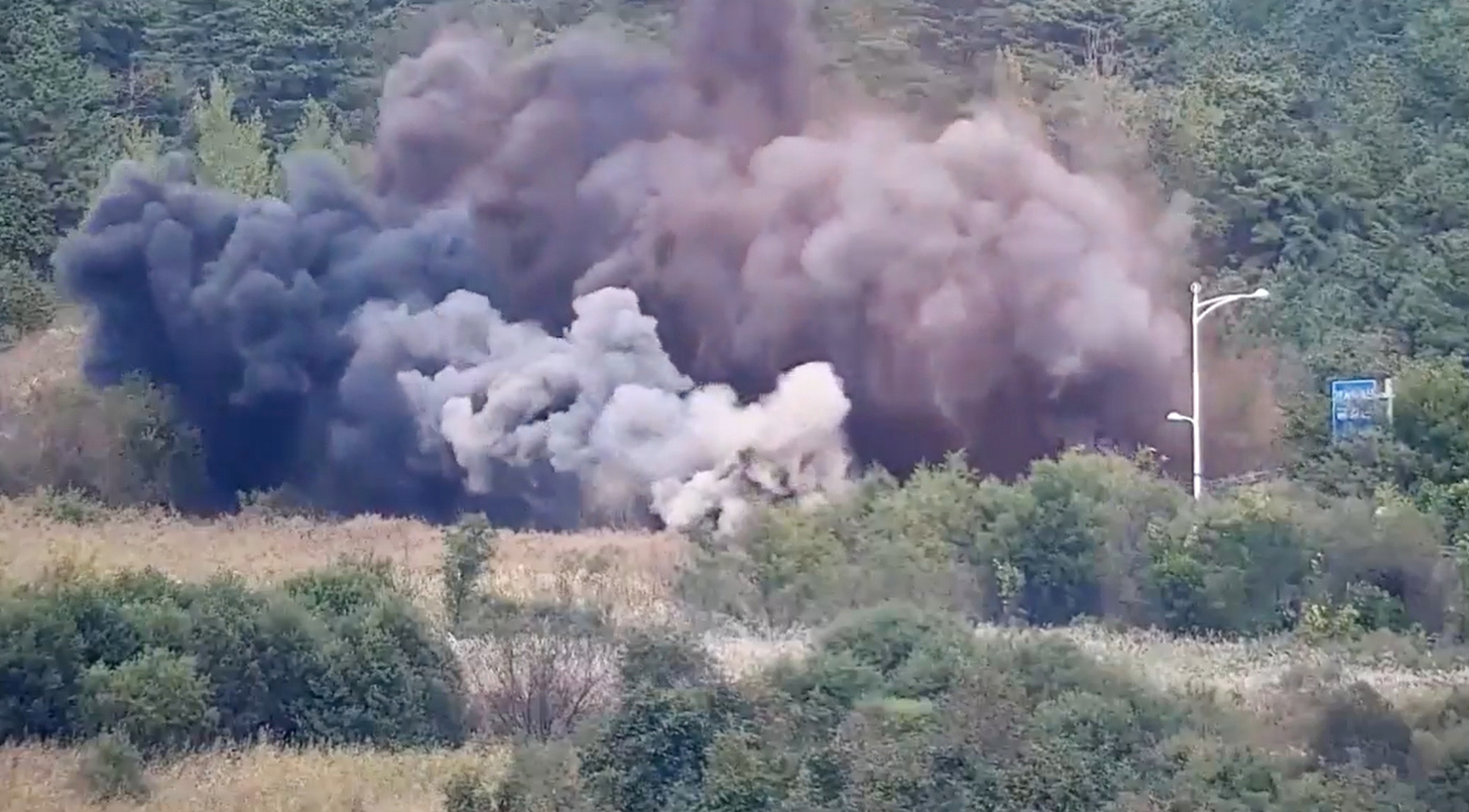In its message to reporters, the JCS said that the North “detonated roads connecting the Gyeongui and Donghae rail lines north of the military demarcation line (MDL) around noon” and that the North Korean military had brought in “heavy equipment to carry out additional work.”
The JCS said the South Korean military responded by firing multiple live rounds from K-6 heavy machine guns and K-4 high-speed grenade launchers at targets located 100 meters (328 feet) south of the MDL, which lies inside the 2.5-mile-wide demilitarized zone (DMZ) that divides the peninsula and constitutes the de facto inter-Korean boundary.
The JCS added that the North’s demolition work resulted in no casualties on the southern side of the border and that the South Korean military “is closely monitoring the North Korean military’s activities and maintains a firm readiness posture amid strengthened surveillance based on cooperation with the United States.”

Neither line has seen regular service over the past decade due to deteriorating relations between Seoul and Pyongyang.
The South Korean Unification Ministry released a statement on Tuesday afternoon criticizing the destruction of cross-border links as an “extremely irregular measure.”
The ministry noted that Seoul had spent approximately $132,290 to connect the northern and southern sections of the Gyeongui and Donghae lines at Pyongyang’s request after the first inter-Korean summit of 2000, when the two sides agreed to build a joint industrial complex at Kaesong.
The South pulled its workers and companies from Kaesong in 2016 and officially dissolved the foundation responsible for managing the zone earlier this year.
The Unification Ministry added that the destruction of inter-Korean links on Tuesday was reminiscent of the North’s decision to blow up the Inter-Korean Liaison Office in Kaesong in 2020 in response to anti-regime leaflets flown over the border via balloons by human rights activists based in the South.
“All responsibility for the destruction of inter-Korean road links lies with the North,” the ministry said.
The explosions came six days after the general staff of the North’s Korean People’s Army (KPA) told Pyongyang’s state-controlled Korean Central News Agency (KCNA) it would “completely separate” the regime’s territory from that of the South.
In the KCNA report, the KPA characterized the measures as “self-defensive” in nature and aimed at “inhibiting war and defending the security” of the North against South Korea, which it described as its “primary hostile state and invariable principal enemy.”
![Footage captured by South Korean surveillance cameras shows the road connecting the Gyeongui Line between the South Korean city of Paju and the North Korean city of Kaesong being detonated on Tuesday. [JOINT CHIEFS OF STAFF]](https://koreajoongangdaily.joins.com/data/photo/2024/10/15/538db63c-c949-4d5a-9475-b983ae6fa97f.jpg)
The KPA’s description of the South mirrored the shift in North Korean leader Kim Jong-un’s view of South Korea, which he characterized as the North’s primary foe in a speech before the regime’s rubber-stamp parliament in January.
The KPA also said that it had communicated its plan in a telephone message to the U.S. military in the South to “prevent any misjudgment and accidental conflict over the fortification project.”
Two weeks prior to the KPA’s announcement, Voice of America (VOA) reported that the North had constructed three to four “large-scale” barrier walls to block traffic on the road that runs along the Gyeongui Line.
According to VOA’s analysis of satellite images taken by Planet Labs, the walls are set approximately 15 meters apart and span the entire 20-meter width of a road segment located approximately 320 meters north of the MDL.
Inter-Korean tensions escalated further after the North claimed on Friday that South Korea had sent unmanned aerial vehicles that dropped anti-regime propaganda over Pyongyang on Oct. 3 and again on two occasions last week.
![Kim Yo-jong, the powerful sister of North Korean leader Kim Jong-un, attends a wreath-laying ceremony at the Ho Chi Minh Mausoleum in Hanoi, Vietnam, on March 2, 2019. [AP/YONHAP]](https://koreajoongangdaily.joins.com/data/photo/2024/10/15/62c600c5-c1c2-4f0c-9810-9281430efa7b.jpg)
On Tuesday, Kim Yo-jong, the influential sister of North Korean leader Kim Jong-un, claimed via state media that the regime had “clear evidence” that the South had sent the drones and vowed to make Seoul “pay a terrible price.”
While Seoul has neither confirmed nor denied Pyongyang’s claim, it warned that the North will see “the end of its regime” if it causes any harm to South Koreans.
In a statement issued Monday, Russia’s Foreign Ministry spokesperson Maria Zakharova called on South Korea to take the North’s warnings “very seriously and cease further escalation on the peninsula through their reckless and provocative campaign, which exacerbates tension and could lead to actual armed confrontations.”
Zakharova added that Seoul should abandon its official commitment to reunification, arguing that “the imposition of pseudo-liberal values and the expansion of certain ‘freedoms’ constitutes a security risk, primarily to its own citizens.”
BY MICHAEL LEE [lee.junhyuk@joongang.co.kr]

![Ex-South Korean President Accused of Trying to Trigger North Korean Attack Former President Yoon Suk Yeol leaves the Seoul Central District Court in southern Seoul after the pretrial detention hearing on July 9. [JOINT PRESS CORPS]](https://www.koreadailyus.com/wp-content/uploads/2025/07/0710-Yoon-100x70.jpg)


